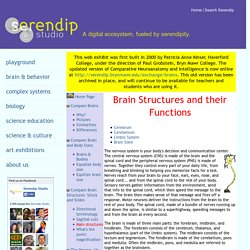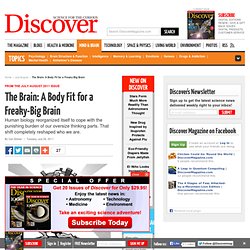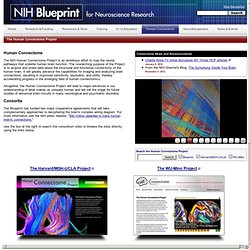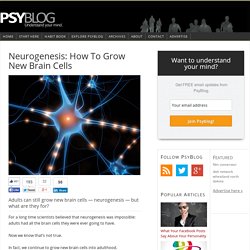

The Whole Brain Atlas. Cognitive Atlas. Brain Atlas - Introduction. The Triune Brain. 3D Brain. Brain Structures and Their Functions.
The nervous system is your body's decision and communication center.

The central nervous system (CNS) is made of the brain and the spinal cord and the peripheral nervous system (PNS) is made of nerves. Together they control every part of your daily life, from breathing and blinking to helping you memorize facts for a test. Nerves reach from your brain to your face, ears, eyes, nose, and spinal cord... and from the spinal cord to the rest of your body.
Science: A New Map of the Human Brain. Who hasn't heard that people are either left-brained or right-brained—either analytical and logical or artistic and intuitive, based on the relative "strengths" of the brain's two hemispheres?

How often do we hear someone remark about thinking with one side or the other? A flourishing industry of books, videos and self-help programs has been built on this dichotomy. You can purportedly "diagnose" your brain, "motivate" one or both sides, indulge in "essence therapy" to "restore balance" and much more. Everyone from babies to elders supposedly can benefit. BrainFacts.org Homepage. Brain Facts and Figures. THE BRAIN FROM TOP TO BOTTOM. THE BRAIN FROM TOP TO BOTTOM. Nuerobiology. The Brain: A Body Fit for a Freaky-Big Brain. Aiello and Wheeler noted that this dramatic increase in brain size would seem to have required a dramatic increase in metabolism—the same way that adding an air-conditioning system to a house would increase the electricity bill.

Yet humans burn the same number of calories, scaled to size, as other primates. Somehow, Aiello and Wheeler argued, our ancestors found a way to balance their energy budget. As they expanded their brains, perhaps they slimmed down other organs. The scientists compared the sizes of organs in humans and other primates. Relatively speaking, our liver is about the same size as a baboon’s. Aiello and Wheeler christened their idea “the expensive tissue hypothesis.” Then William Leonard, a biological anthropologist at Northwestern University, put the expensive tissue hypothesis to a new test.
Human Connectome Project. The Human Connectome Project (HCP) is a five-year project sponsored by sixteen components of the National Institutes of Health, split between two consortia of research institutions.

The project was launched in July 2009[1] as the first of three Grand Challenges of the NIH's Blueprint for Neuroscience Research.[2] On September 15, 2010, the NIH announced that it would award two grants: $30 million over five years to a consortium led by Washington University in Saint Louis and the University of Minnesota, and $8.5 million over three years to a consortium led by Harvard University, Massachusetts General Hospital and the University of California Los Angeles.[3] The Connectome — Harvard School of Engineering and Applied Sciences. Lead investigators Hanspeter Pfister (SEAS ), Jeff Lichtman (FAS/Molecular & Cellular Biology, Center for Brain Science) and Clay Reid (HMS/Neurobiology, Center for Brain Science) Description The overall goal of the Connectome project is to map, store, analyze and visualize the actual neural circuitry of the peripheral and central nervous systems in experimental organisms, based on a very large number of images from high-resolution microscopy.

The proposing team from the Center for Brain Sciences has already demonstrated its capacity for, and expertise in, high-throughput imaging. The Human Connectome Project. The Human Connectome Project Human Connectome The NIH Human Connectome Project is an ambitious effort to map the neural pathways that underlie human brain function.

Sebastian Seung: I am my connectome. Neurogenesis. Neurogenesis (birth of neurons) is the process by which neurons are generated from neural stem cells and progenitor cells.

Most active during pre-natal development, neurogenesis is responsible for populating the growing brain with neurons. Recently neurogenesis was shown to continue in several small parts of the brain of mammals: the hippocampus and the subventricular zone. Neurogenesis: How To Grow New Brain Cells. Adults can still grow new brain cells — neurogenesis — but what are they for?

For a long time scientists believed that neurogenesis was impossible: adults had all the brain cells they were ever going to have. Now we know that’s not true. In fact, we continue to grow new brain cells into adulthood. The race is on to find out what these brain cells are for and how we can grow more of them. Neurogenesis. Exercise Plus Fasting May Boost Brain's Neurons. Forget what you've heard about "brain food"...turns out, the best food for your brain may be none at all.

New research on intermittent fasting and exercise show some surprising brain benefits of depriving yourself of calories -- at least occasionally. "We have evidence that exercise and probably intermittent fasting increase the number of mitochondria in neurons," said Mark Mattson, a neuroscientist at the National Institute on Aging in Baltimore. So far, Mattson and other researchers have studied the phenomenon in animals, and are beginning to understand how intermittent fasting in rats and mice can enhance learning and memory, and how it can decrease the risk of those brain functions degenerating. How You Can Be Fit But Not Healthy. Neuroplasticity. Contrary to conventional thought as expressed in this diagram, brain functions are not confined to certain fixed locations.

Neuroplasticity, also known as brain plasticity, is an umbrella term that encompasses both synaptic plasticity and non-synaptic plasticity—it refers to changes in neural pathways and synapses which are due to changes in behavior, environment and neural processes, as well as changes resulting from bodily injury.[1] Neuroplasticity has replaced the formerly-held position that the brain is a physiologically static organ, and explores how - and in which ways - the brain changes throughout life.[2] Neuroplasticity occurs on a variety of levels, ranging from cellular changes due to learning, to large-scale changes involved in cortical remapping in response to injury. The role of neuroplasticity is widely recognized in healthy development, learning, memory, and recovery from brain damage. Neurobiology[edit] Cortical maps[edit] Neuroplasticity of Forming Habits. Neuroplasticity. How The Brain Rewires Itself. It was a fairly modest experiment, as these things go, with volunteers trooping into the lab at Harvard Medical School to learn and practice a little five-finger piano exercise.
Neuroscientist Alvaro Pascual-Leone instructed the members of one group to play as fluidly as they could, trying to keep to the metronome's 60 beats per minute. Every day for five days, the volunteers practiced for two hours. Then they took a test. Brain Waves. The human brain is more complex than your scientists suspect. They are busily mapping where certain functions occur, and how parts of the brain activate in syncronicity. They know that parts of the brain, near the stem, are older than, for instance, the forebrain, and that a human can survive remarkably well with only half a brain, as long as that half is either the right or left, intact.
But what your scientists do not know is that beyond the old brain and the new, the subconscious and the conscious, the right and the left halves - there are yet more subdivisions of the human brain. Where it is known that the brain seems to specialize in activity that requires Beta frequency brain waves during wakefulness, and Alpha frequency waves during sleep or meditation, and Theta waves during rage, and Delta waves in coma - no one is quite sure why.
We will tell you. BRAIN POWER: From Neurons to Networks. Cooperative Neural Networks Suggest How Intelligence Evolved. Working together can hasten brain evolution, according to a new computer simulation. When programmed to navigate challenging cooperative tasks, the artificial neural networks set up by scientists to serve as mini-brains "learned" to work together, evolving the virtual equivalent of boosted brainpower over generations. The Brain's Highways: Mapping the Last Frontier. Frontiers are in short supply. No explorer will again catch that first glimpse of the Pacific Ocean with “wild surmise,” take the first steps on the moon, or arrive first at the Challenger deep – the remotest corners of the earth are now tourist attractions. Even in science, great mysteries have fallen – life itself has gone from being the subject of metaphysical speculation about vital substances to the biophysical understanding of cellular processes.
Uncharted territories, both physical and metaphorical, are hard to find. First map of the human brain reveals a simple, grid-like structure between neurons. In an astonishing new study, scientists at the National Institutes of Health (NIH), have imaged human and monkey brains and found… well, the image above says it all. A Glance at the Brain’s Circuit Diagram.
How mapping neurons could reveal how experiences affect mental wiring. This article was taken from the July 2012 issue of Wired magazine. Be the first to read Wired's articles in print before they're posted online, and get your hands on loads of additional content by subscribing online. No road, no trail can penetrate this forest. Diffusion MRI image of the brain. What the Synapses in Your Brain Actually Look Like. Know Your Neurons: How to Classify Different Types of Neurons in the Brain’s Forest. Neuron. All neurons are electrically excitable, maintaining voltage gradients across their membranes by means of metabolically driven ion pumps, which combine with ion channels embedded in the membrane to generate intracellular-versus-extracellular concentration differences of ions such as sodium, potassium, chloride, and calcium. Neuron viewed with an electron microscope.
Neuron's cobweb-like cytoskeleton (its interior scaffolding) Making Sense of the World, Several Senses at a Time. Our five senses–sight, hearing, touch, taste and smell–seem to operate independently, as five distinct modes of perceiving the world. In reality, however, they collaborate closely to enable the mind to better understand its surroundings. We can become aware of this collaboration under special circumstances. In some cases, a sense may covertly influence the one we think is dominant. When visual information clashes with that from sound, sensory crosstalk can cause what we see to alter what we hear. When one sense drops out, another can pick up the slack. The Secrets of Your Brain's Zoom Lens. Notice that, even as you fixate on the screen in front of you, you can still shift your attention to different regions in your peripheries.
For decades, cognitive scientists have conceptualized attention as akin to a shifting spotlight that “illuminates” regions it shines upon, or as a zoom lens, focusing on things so that we see them in finer detail. These metaphors are commonplace because they capture the intuition that attention illuminates or sharpens things, and thus, enhances our perception of them. Attention Tunes The Mind's Ear. Why Emotions Are Attention-getters. Neuropsychology. Neuropsychology studies the structure and function of the brain as they relate to specific psychological processes and behaviors. It is seen as a clinical and experimental field of psychology that aims to study, assess, understand and treat behaviors directly related to brain functioning.
The term neuropsychology has been applied to lesion studies in humans and animals. It has also been applied to efforts to record electrical activity from individual cells (or groups of cells) in higher primates (including some studies of human patients).[1] It is scientific in its approach, making use of neuroscience, and shares an information processing view of the mind with cognitive psychology and cognitive science.
History[edit] Imhotep[edit] Brain is not fully mature until 30s and 40s. TO UNDERSTAND IS TO PERCEIVE PATTERNS. How Thinking Works: 10 Brilliant Cognitive Psychology Studies Everyone Should Know. Decision-Making and Control in the Brain. Instant Expert: The Human Brain - life - 04 September 2006 - New. Memories May Not Live in Neurons' Synapses - Futurism. Where our brain stores the time and place of memories: A first view of real-life memories 'on the scale of our lives'
Memory. UCSB scientists discover how the brain encodes memories at a cellular level. Researchers show that memories reside in specific brain cells. Old Memories Interfere With Remembering New Ones. Imagining the Future Invokes Your Memory. The Memory Capacity of Human Brain Could be 10 Times More Than Once Thought. Scientists pinpoint synapses for specific memories in mice - Futurism. Is the Purpose of Sleep to Let Our Brains “Defragment,” Like a Hard Drive? Sleep makes your memories stronger, and helps with creativity.
The Brain May Disassemble Itself in Sleep. The First Real Reason We Need To Sleep. Lucid dreamers help scientists locate the seat of meta-consciousness in the brain. Lucid dreams and metacognition: Awareness of thinking; awareness of dreaming. Nootropics - The Facts About "Smart Drugs" Right Brain, Left Brain? Scientists Debunk Popular Theory. 5 common beliefs about the human brain that are actually totally false. Estimate: Human Brain 30 Times Faster than Best Supercomputers.
30 Amazing Facts About Your Brain. 20 Amazing Facts About Your Brain. Personality Traits Correlate With Brain Activity. Meditation found to increase brain size. The Learning Brain Gets Bigger. How The Brain Processes The #Emotions — P... Neural Mechanisms Linked With Vulnerability To Anxiety. Everyday Stress Can Shut Down the Brain's Chief Command Center. Force of habit: Stress hormones switch off areas of the brain for goal-directed behaviour. Brain Scan Foretells Who Will Fold Under Pressure. Aging Brains Aren’t Necessarily Declining Brains. TEDxOrlando - Wendy Suzuki - Exercise and the Brain. The most important lesson from 83,000 brain scans: Daniel Amen at TEDxOrangeCoast. Neurotechnology. Cognitive Neuroscience Society. Brain. Researchers Connect Animal Brains To Share Thoughts and Solve Challenging Problems.